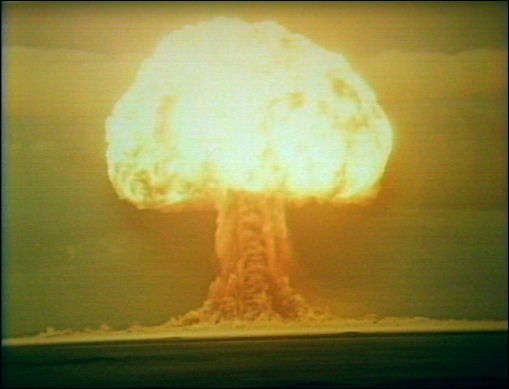Soviet military power - the reverse side of the coin

Recently I have been reading many articles on the main Habr about the weapons of the once great country, our common homeland - the USSR. This shows the healthy interest of the habrosoobschestva to their own history and science. I would like to talk about what the saber-rattling and the buildup of offensive weapons led to and draw conclusions for the future concerning military equipment.
')
1) Ecological problems
In order to test their newest weapons, the Soviet Union needed testing grounds.
The largest and most famous is the Semipalatinsk test site (Kazakhstan). It was here that on August 29, 1949, nuclear weapons were tested for the first time in the USSR. On these events, the film "The Gift of Stalin ."
It was also here that for the first time the Soviet government tested the first thermonuclear device (August 12, 1953) and the world's first hydrogen bomb (11/22/1955). In total, at least 468 nuclear tests were conducted during the use of the landfill. There were both ground and underground explosions, and space explosions. After the collapse of the USSR August 29, 1991, the landfill was closed. But the echoes of the tests will still be very long.
If the Japanese Hiroshima survived the first nuclear bomb, the Semipalatinsk region and the American state of Nevada withstood all the following explosions. There were also polygons

The entrance to one of the test tunnels in the Degelen mountain range (tunnels) where nuclear tests were conducted. Ring structures are clearly visible, supporting a dismantled channel for outputting radiations of very large diameter or an end box with irradiated equipment or materials

Vacuum (evacuated) box at the exit of the radiation output channel from adit 169-2 at the Degelen site. Evacuated boxes were used to obtain in nuclear tests conditions close to those of outer space, probably to test the radiation resistance of weapons and space-based systems.

The first thermonuclear test at the experimental field of the Semipalatinsk nuclear test site. The RDS-6s device (Joe-4), charge type - “puff” (65% of energy release - fission reaction, 35% - synthesis). The height of the blast is 30 meters (tower). Energy release 400 kt [13]. This explosion caused the most significant radioactive contamination of the landfill in the south-west direction and the surrounding areas. Platform Experienced Field Semipalatinsk polygon.

Ground nuclear explosion of ultra-low power (from 1 kiloton or less). Platform Experienced Field Semipalatinsk polygon. Not identified.
Blast on video.
The insane arms race and more and more new nuclear weapon tests naturally affected the health of the local population. Horrific photos and videos just shocking a normal person. Who knows what awaits the descendants of people affected by nuclear tests and how they will generally affect humanity.
A terrible video about the victims of military trials and military actions. Only if the United States tested its armament in external wars, the USSR tested everything on its citizens.
2) Economic problems
As you know, the defense industry is a non-profit industry. And if the construction of a factory or pipeline pays for itself, the creation of military equipment is a permanent loss of money and considerable money.
The situation in which the whole country for seven decades is continuous and works a lot only for defense cannot positively affect the economic health of this country. If the USA, the main rival of the USSR in the arms race, resorted to the help of private companies to develop and build military equipment, in the USSR it was only the state.
The militarization of the economy, which was necessary during the Second World War, did not stop after May 9, 1945. She went ahead and gained momentum. Construction of strategic facilities, the development of new types of weapons, was carried out constantly. And everyone who lived in the USSR at least a little remembers that the military and scientists lived best of all at that time, there was no shortage for them, they had good salaries.
Foreign Minister Shevardnadze, declared in May 1988 that the USSR’s military expenditures made up 19% of the GNP; in April 1990, Gorbachev rounded this figure to 20%. At the end of 1991, the chief of the General Staff, Lobov, announced that the USSR’s military spending constituted one third or even more of the GNP (260 billion rubles in 1988 prices, that is, over 300 billion dollars).
A normal economy, from which from the fifth to the third part of the total income goes to nowhere becomes abnormal and depressive. For a long time this could not continue, and the Country of Soviets lost its stability. And subsequently collapsed.
We still see echoes of our militarization. The countries of the post-Soviet space that inherited their military potential are not able to support it in full, otherwise their already weak and unstable economies will finally collapse on their side. So we only have to proudly recall our shared great past.
PS You should not dig a hole for another, you will get into this hole yourself.
We were leading the arms race.
Time has shown the price of leadership.
UPD. The post was not written with the aim of somehow minimizing the merits of the military-industrial sector of the USSR in the development of science, to shield the United States or to blacken the USSR. The post is written so that we all understand that it is possible to increase military potential indefinitely, but we should not forget about the consequences of such growth.
Source: https://habr.com/ru/post/87751/
All Articles